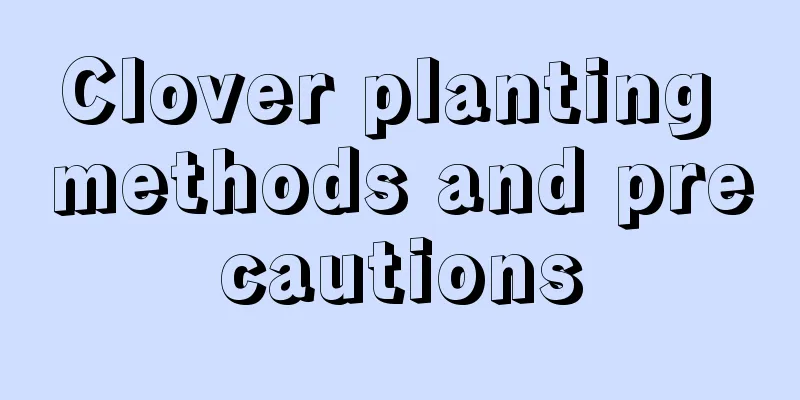Clover planting methods and precautions

|
Clover, also known as clover, is a perennial herb of the genus Trifolium in the Leguminosae family. It grows strongly and has dense plants, making it very suitable for group planting and landscaping. It has high ornamental value, can be used as medicine, and has a wide range of uses. Let's talk about the planting methods and precautions of clover. 1. Soil selection When planting clover, you should use loose, fine and flat soil. Its seeds are very small. If the cultivation soil is too sticky, it will hinder its growth and development. In addition, it is best if the soil contains rich organic matter, which can make the plants grow more vigorously. 2. Appropriate fertilization Clover itself has a certain ability to fix nitrogen, and applying an appropriate amount of nitrogen fertilizer can make the seedlings grow stronger. When it grows and matures, you should apply more phosphorus and potassium fertilizers. In addition, nitrogen fertilizer helps its growth, and phosphorus and potassium fertilizers have the effect of increasing production. The amount of nitrogen fertilizer applied in the later stage must not be too much. 3. Water in time Clover likes to grow in humid places, so it should be watered in time during maintenance and the soil should be kept slightly moist. However, there should not be water accumulation in the potting soil, because if the amount of water is too much, its roots will rot due to poor breathing, and the plant will die. 4. Reasonable lighting Clover can be placed in a relatively bright and well-lit place for maintenance in spring, autumn and winter. Especially in winter, giving clover more sunlight will help it survive the winter. It should not be exposed to the sun for a long time in summer, especially the midday sun, which is very strong, so it should be kept in a cool place. 5. Suitable temperature Clover is a thermophilic plant that grows vigorously in summer and slowly in winter. The most suitable growth temperature for it is around 18-30 degrees. 6. Pest and disease control Clover is rarely attacked by pests and diseases, but it may also be harmed by powdery mildew or brown spot disease. Once the disease occurs, it cannot be ignored and should be sprayed with pesticides in time. It is recommended to use Bordeaux mixture or carbendazim for spraying. If scale insects occur, omethoate can be used for spraying. That’s it |
<<: How to deal with the small lily after it blooms and how to cut it
>>: How to divide the miniature coconut palm and when is the best time to divide it into pots
Recommend
Clivia fertilization and maintenance, the correct way to water
1. Fertilization method Clivia is usually fertili...
Can Paulownia flowers be eaten?
Are Paulownia flowers poisonous? Paulownia flower...
The role of Anthurium
The ornamental value of Anthurium Anthurium is on...
Vinca care in four seasons
Spring Care of Vinca Spring is the season when al...
What to do if the leaves of bougainvillea turn black
1. Excessive watering If you always water it with...
How long are the leaves of green radish? Can the leaves be eaten?
1. Leaf length The leaves of the green radish are...
How many times a year does the longevity crabapple bloom?
Flowering period of longevity crabapple Its flowe...
When is the best time to transplant peach trees?
When transplanting peach trees, in order to incre...
How to prune crabapple after it blooms
Pruning crabapple after flowering Function : The ...
When is the best time to repot the daisy flower?
Gardenia repotting time Generally, newly bought g...
Can the spider plant be repotted in summer? What season is best for repotting?
Can the spider plant be repotted in summer? Chlor...
When and how to plant horn peppers
Planting time of horn pepper There are usually tw...
Ranking of new high-yield chili pepper varieties (what is the highest-yielding chili pepper variety at present)
Mars 8 Mars No. 8 is a newly bred hybrid chili pe...
How long is the growth cycle of cabbage?
Introduction to the growth of lettuce Lettuce is ...
What fertilizer is good for growing radishes?
Fertilizer for growing radish Radish has very hig...









